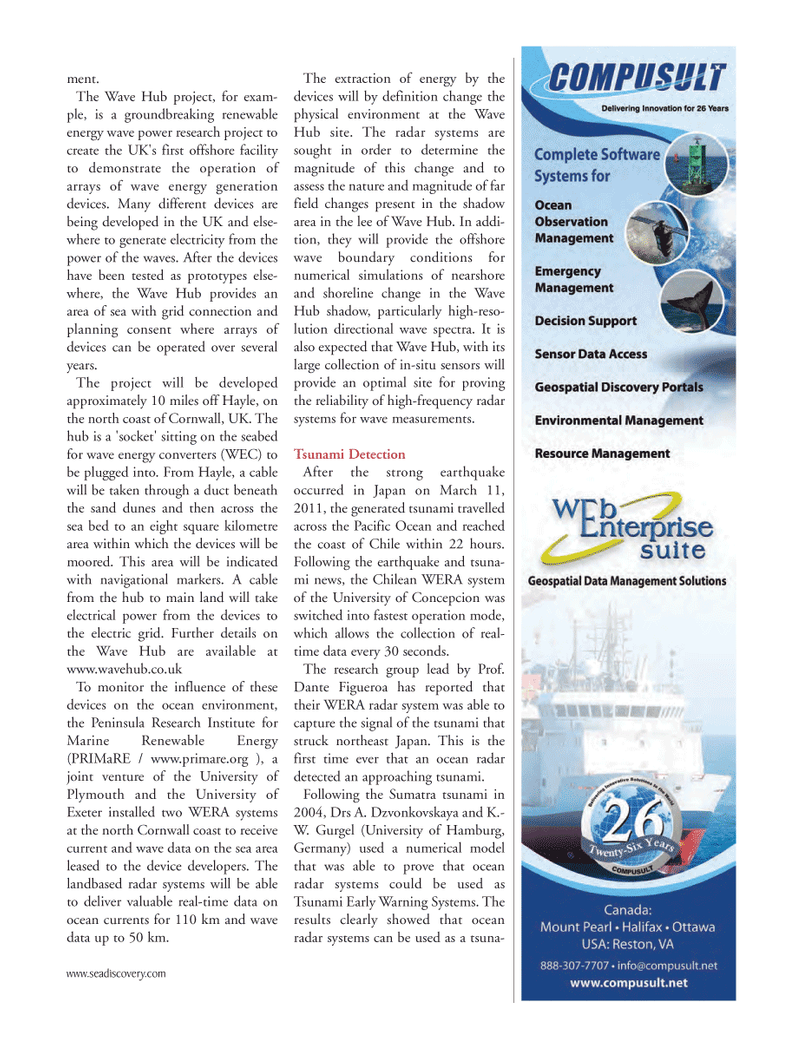
Page 31: of Marine Technology Magazine (September 2011)
Ocean Observation
Read this page in Pdf, Flash or Html5 edition of September 2011 Marine Technology Magazine
www.seadiscovery.com ment.The Wave Hub project, for exam- ple, is a groundbreaking renewable energy wave power research project to create the UK's first offshore facility to demonstrate the operation ofarrays of wave energy generation devices. Many different devices are being developed in the UK and else- where to generate electricity from the power of the waves. After the devices have been tested as prototypes else- where, the Wave Hub provides an area of sea with grid connection and planning consent where arrays of devices can be operated over several years. The project will be developed approximately 10 miles off Hayle, on the north coast of Cornwall, UK. The hub is a 'socket' sitting on the seabedfor wave energy converters (WEC) to be plugged into. From Hayle, a cable will be taken through a duct beneath the sand dunes and then across the sea bed to an eight square kilometre area within which the devices will be moored. This area will be indicated with navigational markers. A cable from the hub to main land will take electrical power from the devices to the electric grid. Further details on the Wave Hub are available at www.wavehub.co.uk To monitor the influence of these devices on the ocean environment, the Peninsula Research Institute for Marine Renewable Energy (PRIMaRE / www.primare.org ), a joint venture of the University of Plymouth and the University of Exeter installed two WERA systems at the north Cornwall coast to receive current and wave data on the sea area leased to the device developers. The landbased radar systems will be ableto deliver valuable real-time data on ocean currents for 110 km and wave data up to 50 km.The extraction of energy by the devices will by definition change the physical environment at the Wave Hub site. The radar systems are sought in order to determine the magnitude of this change and toassess the nature and magnitude of far field changes present in the shadow area in the lee of Wave Hub. In addi- tion, they will provide the offshore wave boundary conditions for numerical simulations of nearshore and shoreline change in the Wave Hub shadow, particularly high-reso- lution directional wave spectra. It is also expected that Wave Hub, with its large collection of in-situ sensors willprovide an optimal site for proving the reliability of high-frequency radar systems for wave measurements. Tsunami Detection After the strong earthquake occurred in Japan on March 11, 2011, the generated tsunami travelled across the Pacific Ocean and reached the coast of Chile within 22 hours.Following the earthquake and tsuna- mi news, the Chilean WERA system of the University of Concepcion was switched into fastest operation mode,which allows the collection of real- time data every 30 seconds. The research group lead by Prof. Dante Figueroa has reported that their WERA radar system was able to capture the signal of the tsunami that struck northeast Japan. This is the first time ever that an ocean radar detected an approaching tsunami. Following the Sumatra tsunami in 2004, Drs A. Dzvonkovskaya and K.- W. Gurgel (University of Hamburg, Germany) used a numerical model that was able to prove that ocean radar systems could be used asTsunami Early Warning Systems. The results clearly showed that ocean radar systems can be used as a tsuna-MTR#7 (18-33):MTR Layouts 8/29/2011 10:03 AM Page 31

 30
30

 32
32
